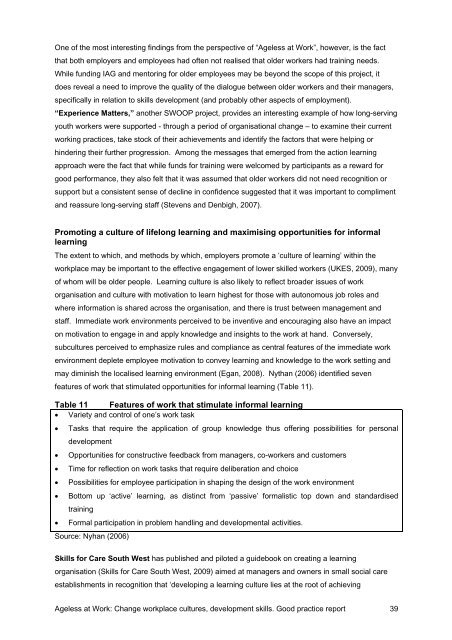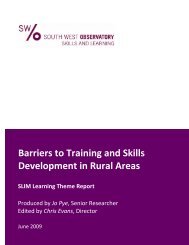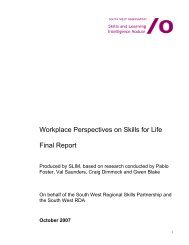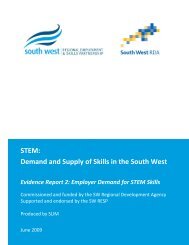Ageless at Work - Skills for Care
Ageless at Work - Skills for Care
Ageless at Work - Skills for Care
You also want an ePaper? Increase the reach of your titles
YUMPU automatically turns print PDFs into web optimized ePapers that Google loves.
One of the most interesting findings from the perspective of “<strong>Ageless</strong> <strong>at</strong> <strong>Work</strong>”, however, is the fact<br />
th<strong>at</strong> both employers and employees had often not realised th<strong>at</strong> older workers had training needs.<br />
While funding IAG and mentoring <strong>for</strong> older employees may be beyond the scope of this project, it<br />
does reveal a need to improve the quality of the dialogue between older workers and their managers,<br />
specifically in rel<strong>at</strong>ion to skills development (and probably other aspects of employment).<br />
“Experience M<strong>at</strong>ters,” another SWOOP project, provides an interesting example of how long-serving<br />
youth workers were supported - through a period of organis<strong>at</strong>ional change – to examine their current<br />
working practices, take stock of their achievements and identify the factors th<strong>at</strong> were helping or<br />
hindering their further progression. Among the messages th<strong>at</strong> emerged from the action learning<br />
approach were the fact th<strong>at</strong> while funds <strong>for</strong> training were welcomed by participants as a reward <strong>for</strong><br />
good per<strong>for</strong>mance, they also felt th<strong>at</strong> it was assumed th<strong>at</strong> older workers did not need recognition or<br />
support but a consistent sense of decline in confidence suggested th<strong>at</strong> it was important to compliment<br />
and reassure long-serving staff (Stevens and Denbigh, 2007).<br />
Promoting a culture of lifelong learning and maximising opportunities <strong>for</strong> in<strong>for</strong>mal<br />
learning<br />
The extent to which, and methods by which, employers promote a ‘culture of learning’ within the<br />
workplace may be important to the effective engagement of lower skilled workers (UKES, 2009), many<br />
of whom will be older people. Learning culture is also likely to reflect broader issues of work<br />
organis<strong>at</strong>ion and culture with motiv<strong>at</strong>ion to learn highest <strong>for</strong> those with autonomous job roles and<br />
where in<strong>for</strong>m<strong>at</strong>ion is shared across the organis<strong>at</strong>ion, and there is trust between management and<br />
staff. Immedi<strong>at</strong>e work environments perceived to be inventive and encouraging also have an impact<br />
on motiv<strong>at</strong>ion to engage in and apply knowledge and insights to the work <strong>at</strong> hand. Conversely,<br />
subcultures perceived to emphasize rules and compliance as central fe<strong>at</strong>ures of the immedi<strong>at</strong>e work<br />
environment deplete employee motiv<strong>at</strong>ion to convey learning and knowledge to the work setting and<br />
may diminish the localised learning environment (Egan, 2008). Nythan (2006) identified seven<br />
fe<strong>at</strong>ures of work th<strong>at</strong> stimul<strong>at</strong>ed opportunities <strong>for</strong> in<strong>for</strong>mal learning (Table 11).<br />
Table 11 Fe<strong>at</strong>ures of work th<strong>at</strong> stimul<strong>at</strong>e in<strong>for</strong>mal learning<br />
Variety and control of one’s work task<br />
Tasks th<strong>at</strong> require the applic<strong>at</strong>ion of group knowledge thus offering possibilities <strong>for</strong> personal<br />
development<br />
Opportunities <strong>for</strong> constructive feedback from managers, co-workers and customers<br />
Time <strong>for</strong> reflection on work tasks th<strong>at</strong> require deliber<strong>at</strong>ion and choice<br />
Possibilities <strong>for</strong> employee particip<strong>at</strong>ion in shaping the design of the work environment<br />
Bottom up ‘active’ learning, as distinct from ‘passive’ <strong>for</strong>malistic top down and standardised<br />
training<br />
Formal particip<strong>at</strong>ion in problem handling and developmental activities.<br />
Source: Nyhan (2006)<br />
<strong>Skills</strong> <strong>for</strong> <strong>Care</strong> South West has published and piloted a guidebook on cre<strong>at</strong>ing a learning<br />
organis<strong>at</strong>ion (<strong>Skills</strong> <strong>for</strong> <strong>Care</strong> South West, 2009) aimed <strong>at</strong> managers and owners in small social care<br />
establishments in recognition th<strong>at</strong> ‘developing a learning culture lies <strong>at</strong> the root of achieving<br />
<strong>Ageless</strong> <strong>at</strong> <strong>Work</strong>: Change workplace cultures, development skills. Good practice report 39








